We may earn revenue from the products available on this page and participate in affiliate programs. Learn more ›
Few things in life can sweep you away and transport you to another time as music can, and few things can bring digital music to you with the transportive power of a good DAC, aka a digital-to-analog converter. The joy and nostalgia that music can bring are hard to overstate, but the feeling will be dulled if you’re relying on stock circuitry built into a basic laptop, tablet, or smartphone, etc. Taking full advantage of music’s expressive power means investing in the components that make it happen. If you’ve already got a good pair of headphones, you need an equally good signal chain, and a DAC is an integral part of that. A DAC’s sole responsibility is to convert the 1s and 0s output by your transport (typically a smartphone streaming music these days) into a signal that your headphones can play. Even though that sounds like a cut-and-dry task, how DACs accomplish this varies, as do the prices, form factors, and features they offer. The best DACs can enhance your listening experience, and we’ve collected the top choices right here to upgrade your listening fast.
How we chose the best DACs
Over my years of reviewing tech, I’ve extensively tested a wide array of audio equipment. I cut my teeth reviewing gaming headsets at MMORPG.com and quickly discovered a love for audio that progressed into a full-fledged love of hi-fi. In the seven years since that first review, I’ve graduated from gaming headsets with built-in components to desktop DACs and amps, portable hybrids that combine them both into one, and smartphone dongles that range from $10 to several hundred. I love diving deep into the world of headphones, and that begins with the gear driving that listening experience.
To create this list, I drew upon multiple sources: user impressions, deep lists of specifications, and, of course, my own experience with several of the products collected. I also researched the pedigree of the different brands producing DACs today and the real-world experiences being shared in forums and Reddit threads. Together, these sources clearly illustrated the best choices for different types of listeners chosen for this list. One note: Audiophile DACs can easily cost thousands of dollars, so I concentrated on primarily sub-$700, bang-for-the-buck choices, most of which are compact but include a headphone amp to cut down on costly components.
The best DACs: Reviews & Recommendations
Now that you know what to look for when shopping for a new DAC, it’s time to choose the best fit for you. Sorting through the masses of different options, some from big brands and some from those that won’t be here in a year, can be confusing. We’ve collected the best choices in several key areas to help cut through the noise.
Best overall: Cambridge Audio DacMagic 200M
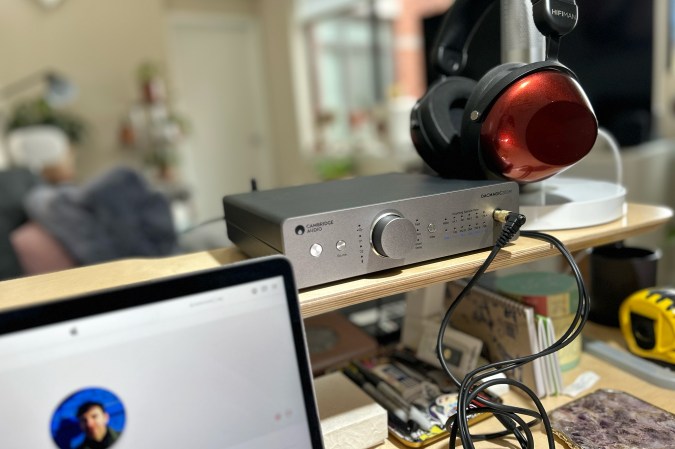
See It
Why it made the cut: The Cambridge Audio DacMagic 200M is an outstanding, fully featured desktop DAC that’s feature-rich and premium without being exorbitant.
Specs
- DAC: Dual ESS ES9028Q2M DACs
- Included amplifier: Up to 300mW for headphones, 4.2 VRMS for speakers
- Bit-depth/sample rate: 32-bit/768kHz
- Format support: PCM, DSD, DoP, MQA
- Bluetooth: Yes—4.2, with SBC, aptX
Pros
- Dual DACs for balanced sound
- Wired and wireless high-resolution listening
- Wide format support
- Plentiful connectivity options
Cons
- Costs a premium
- No LDAC
Since its release in 2021, the DacMagic 200M from Cambridge Audio has been a frequent flier on “Best Of” lists due to its outstanding balance of sound, features, and connection options. It’s easy to see why it’s so beloved: With its combination of dual ESS ES9028Q2M DACs, built-in 300mW headphone amp, wired and wireless connectivity, and premium build quality, it’s the kind of device even a veteran audiophile could stay delighted with for years.
While the other DACs on this list content themselves with a single chip, the DacMagic 200M implements a pair of high-quality ESS chips to reduce crosstalk and improve separation between the two channels. The audio sent from the device is impeccably high-resolution with a maximum bitrate of 32-bit/768kHz and support for the PCM, DSD, and MQA formats. It even supports DoP, which stands for “DSD over PCM,” so it can accept DSD files over USB even if your USB port doesn’t know how to handle the data natively. Pair that with dual digital inputs (your choice of optical or coaxial for each), and USB audio-in, and you have a device that can accept audio from just about anywhere for under $500.
When it comes to sending audio out, the DacMagic 200M has a whole different set of tricks up its sleeves, acting as a preamp perfect if you’re building a components system with a dedicated headphone amp or AV receiver. Turn it to the back and you’ll find RCA jacks and a pair of XLR ports to drive balanced and unbalanced speakers, making this stylish Lunar Grey aluminum enclosure a best desktop DAC aesthetically and functionally. A ground lift switch sits on the other side to eliminate any hum that might be coming from your home electrical system. You can even apply digital filters that fine-tune the already expansive 10Hz to 50kHz frequency response. But that’s not all: under the hood is a built-in headphone amplifier that can enhance the resolution of easily driven bass cannons (like the HiFiMAN HE-R9 pictured) or even fill in at the fringes for demanding, high-impedance headphones (like the richly textured Sennheiser HD 660S2) so you can get listening right away or integrate it into a larger setup.
Wireless audio does feel like a bit of an afterthought, though. The DacMagic’s Bluetooth receiver only supports version 4.2, and we’re now seeing products sporting a whole version higher (up to Bluetooth 5.4) that offer better reliability and power efficiency. And though it’s great to see the DacMagic have a more-resolving signal than vanilla Bluetooth thanks to its aptX codec, it still falls short of the quality delivered by LDAC or aptX HD/Adaptive found on competing Bluetooth DACs. If it’s wireless fidelity you’re really after, look into the Cambridge Audio MXN10—a Wi-Fi Network Audio Player/ESS SABRE ES9033Q DAC that longs to be fed Spotify Connect, TIDAL, Deezer, and/or Qobuz, as well as Airplay 2 and Roon streams, though you will need to pair it with a headphone amp.
Best DAC/amp combo: iFi xDSD Gryphon
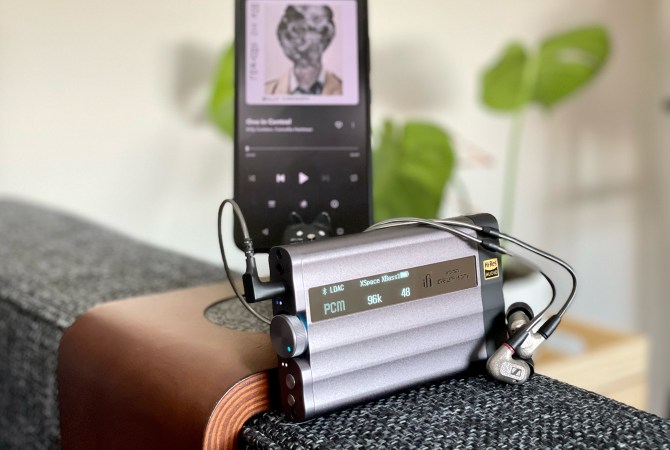
See It
Why it made the cut: The iFi xDSD Gryphon is a hybrid that does it all, offering excellent wired and wireless connectivity, a built-in battery, and tons of rich, powerful sound.
Specs
- DAC: Burr-Brown
- Included amplifier: Up to 1000mW
- Bit-depth/sample rate: 32-bit/768kHz
- Format support: PCM, DSD, DXD, MQA, DoP over S/PDIF
- Bluetooth: Yes—5.1, with SBC, AAC, LDAC, LHDC, aptX HD/Adaptive
Pros
- Outstanding sound quality, whether wired or wireless
- Powerful built-in DAC with 3 selectable digital filters
- Customizable sound with built-in XBass II and XSpace switches
- Informative OLED screen
Cons
- No track controls
- Expensive
- Larger for a portable
At first blush, the iFi xDSD Gryphon might seem expensive at around $600, but it’s hard to find another portable combo DAC/amp that’s quite as full-featured as this one without paying more. With a corrugated metal casing with an OLED display strip on top, outputs, and a control panel at one end and plastic-capped inputs at the other, the flask-sized Gryphon is distinctive aesthetically but truly extraordinary internally.
It features a high-quality 32-bit Burr-Brown chipset (the same one used in a multi-thousand-dollar flagship DAC/amp) with support for all manner of high-end audio, whether standard MP3s presented in HD or proprietary file types like DSD, DXD, or MQA for streaming hi-fi over TIDAL. The Gryphon outputs support balanced (4.4mm) and single-ended (3.5mm) headphones and earphones—no matter how you want to listen, this hybrid DAC is ready to offer a great experience. A Gryphon even holds the distinction of being one of our associate managing editor’s go-to components (pictured above with the equally compact, amply immersive Sennheiser IE 600 and an ASUS ROG Phone—a sweet streaming suite for a personal audio enthusiast).
The magic of the Gryphon lies in its versatility. When fully charged, you can cut the cord and use it for up to 8 hours on the go with Bluetooth streaming over SBC, AAC for iOS, and up to 96kHz using LDAC, LHDC/HWA, or aptX HD/Adaptive on Android devices. Or you plug it in via USB, Coax, or Optical and ensure that no audio bit gets adulterated by wireless compression. Once you’re listening, you can enhance bass and/or upper midrange presence, as well as soundstage, with iFi’s innovative XBass II and XSpace analog enhancements. Connected to your PC over USB-C, it will act as an external soundcard, eliminating the need for a dedicated desk setup—perfect with headphones and, when the Gryphon is accepting a digital source, ports on the back can even be used to feed an external amp or powered monitors.
The tremendous 1000mW @ 32 ohms of power on offer over its balanced DAC connection also means the Gryphon can drive even very demanding headphones. The single-ended connection is much more limited at 320mW but is still enough to drive the vast majority of cans available today. If you’re a fan of sensitive in-ear monitors (IEMs), don’t worry because the Gryphon also offers an iEMatch mode (assignable to either output) to prevent hiss from invading your favorite tracks, while maintaining dynamics. As for the tonality, the Gryphon emphasizes not emphasizing any one thing. It respects the symmetry between impact and imaging, staying as articulate as it is energetic. Its sound-shaping features can fatten up the speedy, textured bass but not to the detriment of organic midrange expression and shimmering treble details.
Despite checking nearly every box an audiophile could request, there are still a few missing features here. Track controls are completely absent, so you’ll still reach for your smartphone to play or pause. I would have also liked to have seen some belt clip or travel case included because the device is about the same size as a modern smartphone and roughly twice as thick. If you’re carrying anything else in your pocket, the Gryphon isn’t likely to fit. All that said, this DAC-amp combo has set a high standard for transportable hi-fi.
Regarding DACs, iFi offers something for every scenario and budget. Got a smartdevice or laptop with USB-C ports and want a plug-in-play improvement of your audio output? The iFi GO link is a $59 dongle housing an ES9219 USB DAC and S-BAL 3.5mm headphone jack that supports 32-bit/384kHz/DSD256/MQA (and it comes with a Lightning adapter for iPhones). It’s not high-powered, but it is hi-res. On the other end of the price spectrum, the $1,299 iFi Diablo 2 is a transportable Burr-Brown multibit DAC/amp that’s chunkier than the xDSD Gryphon but has even more output for those extremely demanding headphones (a real-world 2 watts), plus Bluetooth 5.4 with aptX Lossless/LDAC to make sure what you’re feeding them maintains rich character.
Best USB: Questyle M15i
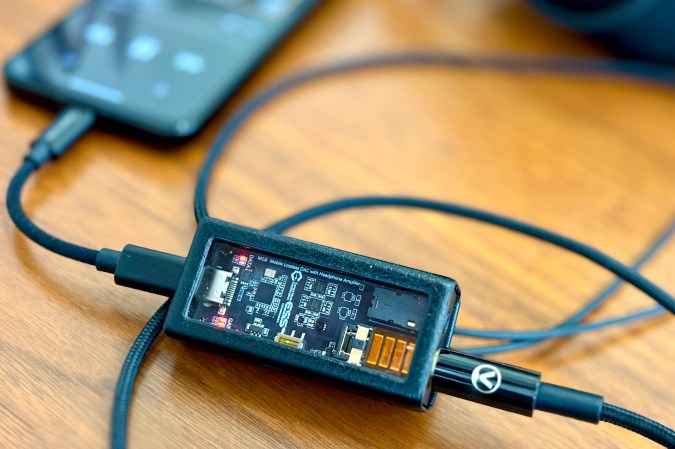
See It
Why it made the cut: The Questyle M15i looks as good as it sounds and has power to spare.
Specs
- DAC: ES9281AC
- Included amplifier: 1.895 Vrms (single-ended), 2.624 Vrms (balanced)
- Bit-depth/sample rate: 32-bit/768kHz
- Format support: PCM, DSD
- Bluetooth: No
Pros
- Rich, warm sound
- Very quiet, low background noise and distortion
- Unique, eye-catching look
- Very pocketable and easy to carry
Cons
- Costly
- Glass panel seems prone to scratching
- No volume rocker or track controls
- Wired only
The Questyle M15i is far from the only USB DAC on our list—everything offers USB connectivity on our list—but it is the most unique pocket DAC on our list thanks to its see-through glass side panel. However, this is not a case of putting form over function—though it is a captivating machined aluminum case. Two colorful LEDs on the circuit board indicate gain level and active bitrate. And what the M15i offers up in aesthetics, it matches in sound quality. The M15i doesn’t come cheap at $299 (though it’s been on sale at $249 before), but it offers power, portability, and outstanding quality that make it an audiophile favorite and an all-around compelling buy. Whether you’re looking to power sensitive IEMs or even moderately demanding headphones, the M15i is versatile enough to see you through.
The Questyle M15i is small but mighty. It uses the boutique amp designer’s signature CMA (Current Mode Amplifier) SiP modules to offer up 1.895 volts through its single-ended output and 2.624 volts through its 4.4mm balanced connection. While you’ll probably want to use it with IEMs on the go for their easy portability, a physical gain switch on the side offers up the extra juice you’ll need for more demanding over-ear headphones (though we recommend sticking with the high-powered balanced output for less sensitive gear). It supports high-res audio with its ESS ES9281AC DAC, a Sabre chip that supports 32-bit/768kHz PCM and DSD512 decoding. And, with a short cord terminated in USB-C (or a USB-C-to-Lightning connector, sold separately), it plays nicely with Android or iOS devices—and it doesn’t draw power until it’s fed signal. This small touch makes a big difference when preserving precious smartphone battery life.
What really sets the M15i apart is how silent it is. There’s no hiss, no white noise hiding behind tracks, so when your music gets quiet, it’s truly noiseless. This black background allows the M15i to step out of the way and remove the barrier between you and your music. Exceptional dynamic range and a pleasant, full-bodied warmth highlight the experience, carrying you from quiet refrains to bold crescendos with impressive ease.
Like most things in life, the M15i isn’t perfect. There’s no way around how expensive it is, and at this price, it would be nice to see value-adding features like Bluetooth support, app-based sound customization, or on-board track and volume controls. The glass side-panel, while gorgeous, also seems like a prime target for scratches if you keep anything else in your pocket. Still, it’s a great fit if you’re looking for rich sound in a striking package.
Need to save money more than you need a balanced output? The M12i features a single CMA SiP module and a 3.5mm single-ended connection but keeps all the same convenience for just $199 (sometimes $149 at retail).
Best smartphone DAC: Moondrop MIAD 01
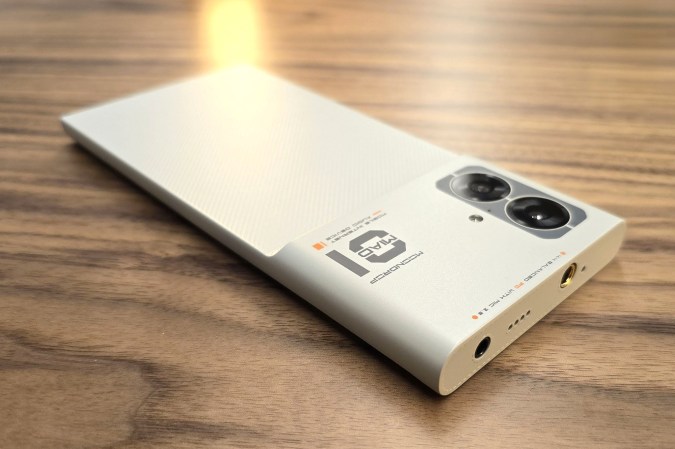
See It
Why it made the cut: This mid-range smartphone features its own DAC/amp setup and even includes a balanced headphone output.
- DAC: Cirrus Logic MasterHiFi
- Included amplifier: 2 Vrms (single-ended), 4 Vrms (balanced)
- Bit-depth/sample rate: 24-bit/192kHz
- Format support: PCM, DSD
- Bluetooth: Yes—SBC, AAC, LDAC
Pros
- Single-ended and balanced headphone outputs
- Ample power output for headphones and IEMs
- Automatically bypasses Android sample rate limits
- All-in-one design makes it exceptionally convenient
Cons
- Phone specs aren’t great
- Poor camera
Nobody really wants to carry multiple devices in their pocket, and with the Moondrop MIAD 01, you maybe won’t have to. This affordable 5G smartphone brings back not one, but two headphone jacks for your balanced and single-ended headphones. Internally, it features dual Cirrus Logic MasterHiFi amps and a powerful amplifier for a clean listening experience across a wide range of headphones and IEMS. Just as importantly, it bypasses the sample rate limitation built into Android, so you can listen to lossless streaming services in true high fidelity.
It offers impressive audio specs for a smartphone: 24-bit, 192kHz sampling, 132dB of dynamic range, a signal-to-noise ratio of 117dB, and up to 4 Vrms of power from its built-in amplifier. You won’t need to worry about missing details or noise in your line with this phone. It’s made with sound quality in mind.
At less than $400, it’s well-priced and offers a selection of key features that help it to compete in the wider smartphone world. It features a large 6.7-inch Full HD (2460 x 1080P) 120Hz AMOLED screen with curved edges, a 5,000 mAh battery, fast charging, 12GB of memory, and 256GB of storage. It also supports microSD cards to expand that up to 2TB, returning yet another missing feature. The only downsides are its processor and camera, which both fail to impress. You’ll be able to browse the web and take pictures, just don’t expect it to replace your iPhone anytime soon. So, you might end up like our managing editor, who uses an iPhone 15 as his daily driver but keeps an Android smartphone on hand (specifically the ASUS Zenfone 10) for testing various Bluetooth formats/wired earphones. For what it offers, the Moondrop MIAD 01 is a best value pick that puts convenience and sound quality at the top of its priority list.
Most portable: Qudelix-5K
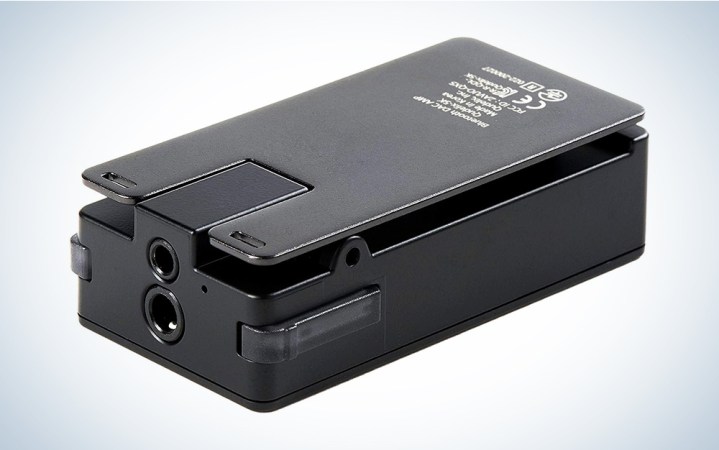
See It
Why it made the cut: This tiny DAC is small yet has enough power for nearly every in-ear monitor you can buy—single-ended and balanced.
- DAC: Dual ES9219 DACs
- Included amplifier: 2 Vrms (single-ended), 4 Vrms (balanced)
- Bit-depth/sample rate: 24-bit/96kHz
- Format support: PCM, DSD
- Bluetooth: Yes: AAC, aptX-HD, aptX Adaptive, LDAC
Pros
- Small, lightweight, and can be used wirelessly
- Lots of driving power
- Parametric equalizer
Cons
- No MQA support
- Limited bit and sample rates
Released in 2020, the Qudelix-5K has been a top recommendation for the entirety of its lifespan, and it’s easy to see why. This tiny DAC/amp hybrid is the definition of portable, blending great features and sound quality with versatility that is unmatched for its asking price. This is the DAC for you if you want a sturdy companion that doesn’t skimp on features or sound quality.
The Qudelix-5K is small enough to slip into a pocket or clip onto a belt and can be enjoyed wired or wirelessly with high-res LDAC, aptX HD, or aptX Adaptive. It supports single-ended and balanced headphones (albeit the older 2.5mm format), and with up to 4 Vrms of power, you won’t have to worry about driving power even for many over-ear headphones. A pair of ES9219 DACs offer up to 24-bit/96kHz audio with support for traditional PCM format, as well as DSD (sorry, MQA holdovers). It will also work with your PC or laptop to enhance your audio anywhere you may be listening.
Its most unique feature is its built-in DSP. Using Qudelix’s app, you can turn on a full 10-band parametric equalizer and digital filters. This allows you to dial in the sound of your earphones with precision, offering you far more control than most DACs around this price. If you don’t want to worry about dialing in your own settings, you can also access the AutoEQ project directly through the app for easy access to premade profiles of many headphones. For the price, the Qudelix-5K is a tremendous choice that’s likely to become a staple of your daily travels.
Of course, ultra-portable DACs now come in countless flavors. For instance, the $199 THX Onyx (yes, that THX) is a rubber-sheathed, aluminum-reinforced, single-ended option about the size of a pack of stick gum with a THX-AAA amp known for its punchy dynamics and jet-black background. While the $45 Hidizs SD2 is an angular USB-C-to-3.5mm Hi-Fi adaptor that’s as plug-and-play, quickly pack away as it gets.
Best for gaming: Creative Sound Blaster X4

See It
Why it made the cut: Made for gaming, the Creative Sound Blaster X4 is packed with features that make for a stellar entertainment experience.
Specs
- DAC: Undisclosed
- Included amplifier: 1.3 – 2.9 VRMs
- Bit-depth/sample rate: 24-bit/192kHz
- Format support: PCM, Surround 7.1, Dolby Digital Live
- Bluetooth: No
Pros
- Multi-platform support: PS5, PS4, Mobile, Windows, Mac
- Virtual surround sound and other gaming-specific features
- Mic support with built-in communication features
- Plentiful software controls and onboard memory
Cons
- Plastic construction
- Lower resolution
- Limited file format support
The Creative Sound Blaster X4 is tailor-made for gaming. While other DACs might work, the X4’s plentiful connectivity, built-in presets, rich software suite, and onboard memory make it the go-to choice for gamers who want to level-up their listening experience for under $150. Best of all, it offers native support for PlayStation 5, Nintendo Switch, Windows, and even macOS.
Once taken out of its box, you’ll first notice its bold and easy-to-grab volume knob. The next thing you’ll notice is its sheer amount of inputs and outputs. As a gaming device, there are ports for both a headset and a microphone on the front edge. Around the back is a full set of surround sound speaker ports and line-in, optical line-out, and USB jacks. The X4 comes with several clickable presets to quickly tailor the sound for gaming, music, or movies without ever opening a piece of software.
But it would be best if you planned on using the software suite because that’s where you’ll be able to tap into the full suite of options. A 10-band EQ allows you to tailor the sound and save those to the device. You can also enable gaming-specific features like virtual surround sound, SXFI Battle Mode, and Scout Mode to enhance situational awareness, and even enhance the quality of your microphone with noise removal and a vocal equalizer.
The biggest downside to the Creative Sound Blaster X4 is that, since it leans so heavily into its gaming features, it falls short when it comes to resolution and file support—quality is limited to 24-bit/192kHz. That’s enough for a great listening experience, but definitely falls short of other options on this list.
Best splurge: Chord Mojo 2
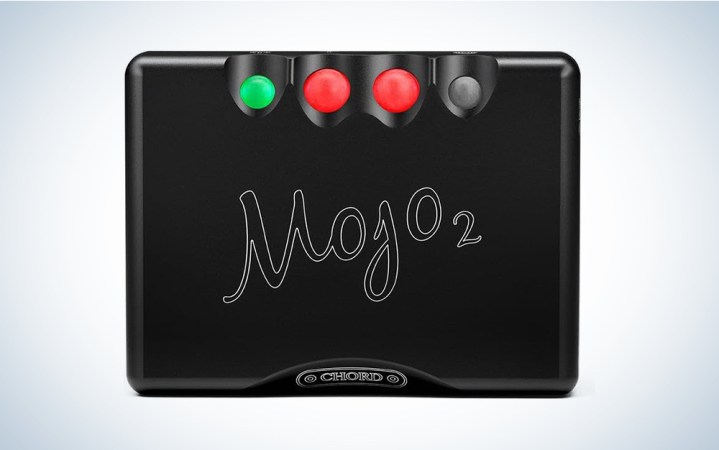
See It
Why it made the cut: The Chord Mojo 2 upgrades the original with better sound and more options.
- DAC: 4e Pulse Array
- Included amplifier: Up to 5.2 Vrms
- Bit-depth/sample rate: 32-bit/768kHz
- Format support: PCM, DSD
- Bluetooth: No
Pros
- High power output
- Lossless digital tone controls
- Outstanding detail and soundstaging
Cons
- Strange, color-based controls
The original Chord Mojo was regarded as one of the best portable DAC/amp hybrids you could buy—if you could afford it. Its successor, the Chord Mojo 2, is even better, offering better battery life, exquisite build quality and controls, and the ability to adjust the sound of your music without losing an ounce of sound quality. Its custom circuitry leads to class-leading transparency, allowing you to hear the strains of your favorite song with pristine neutrality or colored to your exact preference, whether you use the USB-C, COAXIAL, or Toslink input (if you want to add wireless/microSD playback, you have to purchase the Chord Poly module separately).
The Mojo 2 uses a unique DAC system that British engineers/manufacturers Chord Electronics calls its 4e Pulse Array. This system encompasses the DAC and amplifier systems and does away with coupling capacitors for enhanced neutrality. It also features 40 DSP cores that power its new noise-shaper adjustment system. This gives you nearly 20 steps of adjustment across the bass, mids, and highs. You won’t need to worry about these changes introducing distortion or other strangeness either. Every step is clean and crisp, making it one of the best on-board EQs we’ve come across.
The Mojo 2’s design is very similar to the original. The aircraft-grade aluminum cube’s controls take the shape of colored spheres. Each color represents a different function, and they can be cycled through with the newly added menu button. Although it can be a bit confusing at first, memorizing the colors isn’t difficult, and it’s well worth the effort for its iconically excellent sound. If it’s purity of signal you want and/or sound customization you crave, you can have both with this high-end for hi-fi component. At $649, it’s a bit more than the other picks on our list (and double that if you add in the Poly), but it’s got undeniable personality and power.
Best budget: Topping DX1 Mini
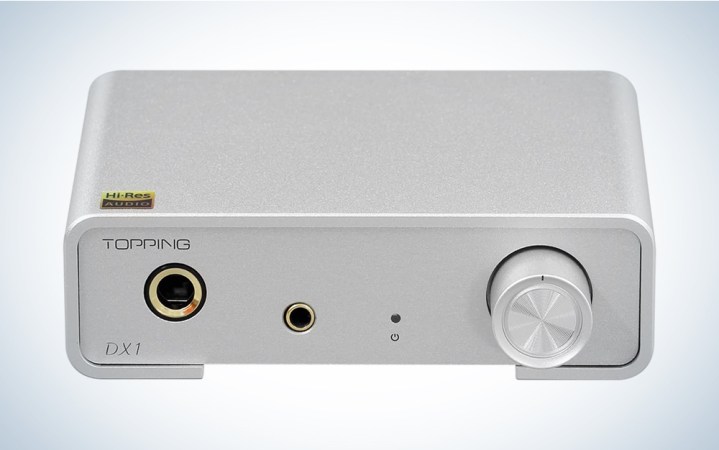
See It
Why it made the cut: This tiny DAC is an affordable upgrade to your system’s built-in audio and even includes a built-in amplifier.
- DAC: AK4493S
- Included amplifier: Up to 280mW
- Bit-depth/sample rate: 32-bit/384kHz
- Format support: PCM, DSD
- Bluetooth: No
Pros
- Small and stylish
- Built-in amplifier
- Works with both headphones and speakers
Cons
- No MQA support
- No balanced output
Topping is one of the biggest brands in the global budget DAC market (though with options that go up to almost a grand), and the company has built an impressive reputation for its products’ quality. The Topping DX1 Mini is designed to be an easy entry-point to the world of superior sound quality, offering a quality DAC and reasonably powerful amplifier, all for around $100. It’s readily available on Amazon, too, so you can take advantage of Prime shipping and have it to your door in no time.
Inside its surprisingly robust aluminum chassis (available in black or silver), it uses a high-quality AKM AK4493S DAC that can output audio up to 32-bit/384kHz and supports Direct Stream Digital files up to DSD256. It also delivers up to 280mW at 32 ohms and 51mW at 300 ohms, so you can drive all but the most difficult headphones. RCA ports on the back also allow you to connect it to speakers, and you won’t even need a spare outlet to add it to your setup. It’s powered over USB and even features a special noise filter to ensure any noise coming across the USB connection so you can have the widest dynamic range and most detail possible.
Given its affordable pricing and convenience-based design, there are a couple of limitations to keep in mind. There’s no MQA support on this model, so certain TIDAL tracks aren’t compatible (though other lossless formats are). There’s also no balanced output for headphones, so you’re stuck with 3.5mm or 6.35 connections. Its maximum resolution could also be better, though you’d be hard-pressed to tell the difference stepping up to 32-bit/768kHz. If you demand the highest specs, the Topping E30II Lite trades the amplifier for higher resolution for around the same price. The DX3 Pro+ gives you the best of both worlds at a higher cost. For the money, the DX1 Mini is the best value, giving you both a DAC and amp in a tiny form factor that will leave you wondering why you waited so long to upgrade.
Things to consider before buying one of the best DACs
Choosing the best DAC can be confusing. Even as someone who has been in the hobby for several years, I still find myself researching the differences between different DACs and their features, so if you’re feeling overwhelmed, don’t worry. There are a few key things to remember that can help any DAC shopper. Here are the most important points to consider before pulling the trigger.
Portable or desktop
Do you aim to listen at home or on the go? That should be the first question you ask before seriously shopping for a new DAC. Desktop DACs are often larger and require external power, either over USB or from a standard wall outlet. Portable DACs are much smaller and are made for travel. They sometimes include batteries to preserve the life of your smartphone and may even include a Bluetooth receiver for wireless listening.
Though you’ll often pay more for the freedom they offer, portable DACs can usually connect to your PC as well, thanks to their USB connectivity. That doesn’t mean they’re exactly the same or the best fit for home listening, however. Since they’re made to be self-enclosed units, DACs like the Chord Mojo 2 and won’t integrate with larger audio systems as easily (or at all) and lack connections for dedicated speakers. If all you’re using are headphones and in-ear monitors, a good portable DAC can be a perfect choice, but if you have other audio equipment already, standalone options like the iFi Audio Zen DAC or AudioEngine D1 are a better fit.
What DAC chip does it use?
The job of any DAC is the same: to convert the digital output of a computer or smartdevice into an analog impulse that headphones and speakers can play. This processing is done through a small computer chip, and if you’ve ever plugged in a pair of monitors into a headphone jack, you’ve heard the results. But even though the end goal is the same, not all DACs are created equal or go about their conversion similarly. The first thing to know before hitting that “Buy Now” button is exactly what DAC chipset your device is actually using.
There are several major brands in the DAC world, but very few actually produce their own conversion chips. Instead, they utilize chipsets from other brands, like ESS, AKM, Cirrus-Logic, and Burr-Brown. Like any good tech brand, these companies scale their products to offer different features and match the calibers of DAC they may be implemented in.
Some of them have better features, like support for boutique file formats or higher-resolution playback. Others offer less measurable noise and distortion (though whether you’ll actually hear the improvement isn’t a given). Many users report certain sound characteristics aligning with different DAC chipsets. ESS DACs, for example, are frequently described as being more resolving, which can mean sharper, more “exciting” treble. Conversely, AKM DACs are “warmer,” which typically means weightier bass with slightly less treble. Some people may love the operating system of their DAP (digital audio player) but aren’t as sold on the output of its headphone jack(s), so they might tether it to a DAC/AMP to enjoy a specific sound signature. It’s important to note that a DAC isn’t intended to color the sound to the noticeable degree of a tube amp, for example, but rather to remove anything taking away from the signal. So don’t expect huge flavor fluctuations between brands on identical settings.
While most DACs clearly label which chip they’re built around, deciphering the differences between chips isn’t always straightforward. It usually means taking a close look at feature and specification lists to determine whether they will make a real-world impact on your listening experience. On the technical side, you’ll need to look at specifications like bit-depth and sample rate. Others, like frequency response and signal-to-noise ratio, are also important to determine the sound’s scope and clarity. Before buying any DAC, it’s a good idea to type that particular chipset into Google and read some expert impressions about its performance and what real listeners like yourself are saying.
But specs aren’t all …
Connectivity and playback options
Two other important considerations when choosing a DAC are its connectivity and playback options. Connectivity refers to its inputs, outputs, and wireless connection options. Can it receive audio the way you’d like to send it: USB, optical, or coaxial? Once it receives that audio, how can it send it back out again?
The output options are especially key. Depending on the model you’re interested in, you may find that its outputs are either too limited or too plentiful, which means you’re probably paying for features you don’t need. Suppose your amplifier or headphones use a balanced connection (circuitry common for high-end headphones, earphones, and amps pairing conductors that can deliver higher power and lower interference). In that case, it’s also important to double-check that your DAC supports that configuration so everything connects properly and takes full advantage of your equipment. (It is possible to damage incompatible equipment, so match accordingly.)
Along with that, and directly related to the first consideration we discussed, you need to ensure that the DAC can support the file types and streaming services you would most like to use. Premium streaming service TIDAL’s Master Quality tracks may sound the best to your ears. Still, you’ll need a DAC that can properly decode those files because some of them still use a format known as MQA, or Master Quality Authenticated—a form of compression that “folds” and “unfolds” audio at varying resolution levels to stream higher bitrates efficiently, and not all DACs can take full advantage of it. It can also be wise to think ahead about what you might like to listen to in the future. You might not listen to high-resolution DSD (Direct Stream Digital) files right now, but if you fall deeper into the hobby, you may want the option down the line. Planning ahead may cost a little more upfront but can save you a bundle from buying a whole new DAC in the future.
Does it include a headphone amplifier?
Even the best DAC is useless without a dedicated amplifier or integrated AV receiver or other means to power the headphones or speakers connected to it. Some DACs, often called hybrids or combos, solve this problem by having an amp built-in. The FiiO K19 is a high-end version of exactly such a device (or the FiiO R9 if you want to add in full media streamer/network player capabilities and much more), but you don’t have to break the bank to find a quality all-in-one solution. FiiO’s E10K Olympus 2 is only $100 and can fulfill your DAC and amp needs in one tiny, affordable box.
If you do choose a hybrid DAC, be sure to check its output power. Most modern headphones don’t require a lot of juice to drive, but some audiophile favorites and mixing headphones still do, like the Sennheiser HD650, HIFIMAN Sundara, or beyerdynamic DT1990 Pro. The best planar-magnetic headphones are particularly power-hungry; even something relatively source-friendly like the Meze LIRIC II shows its best delving into bass depths and textured details when fed more current. Because every headphone is different, it’s difficult to say exactly how much power you’ll need. We recommend putting your headphones through a power calculator to determine how many milliwatts and volts your preferred headphones will need.
Price
Finally, we come to the price. The cost of audio gear can range widely, whereas one DAC might be $200, another might be $2,000, even when running similar chipsets. Does that second DAC really sound 10 times better than the first? Probably not (though it’s almost certainly an improvement). So much of the hi-fi hobby is about incremental gains and those margins only become thinner as the price scales up. Diminishing returns are a very real consideration for anyone in the audio hobby.
If you’re new to the world of DACs and amps, it’s wise to set yourself a reasonable budget and stick to it. Just because something is more expensive doesn’t mean it will sound better. This is especially true when you’re early in the hobby and may be unable to hear the difference between two DACs—even when others claim to. Research the options that meet your needs and budget and choose the best option among the bunch.
FAQs
Absolutely, but don’t expect your listening experience to be completely different. The most noticeable upgrade many listeners experience is when switching from the built-in audio on their PC, for example, to an external DAC for the first time. This is because an external DAC physically separates its audio components from the rest of the computer, reducing or eliminating electrical interference that comes through and white noise, digital artifacts, and distortion through your headphones. The experience is often enhanced by the fact that dedicated DACs are almost always better and more feature-rich than the integrated chips built into motherboards.
Beyond this point, DACs tend to offer incremental improvements. While there are differences in sound quality, usually, these can be difficult to hear for less experienced listeners. Investing in the best DAC is first about investing in a dedicated audio solution. After that, it’s about allowing your headphones to play at their full potential across multiple file types and sources.
Expensive DACs rely on premium components and boutique engineering to push the listening experience to its theoretical maximum. Premium DACs often tout distortion levels far below audible levels and include features like femtosecond clocks that keep the timing of its audio bits to the quadrillionth of a second. In short, much of the “quality” difference isn’t going to be something you can actually hear.
That doesn’t mean pricier DACs have nothing to offer, however. More expensive DACs tend to include advanced features like full high-resolution DSD playback. They’ll typically offer more and better connectivity, including features like high-resolution wireless streaming and at least one balanced output. It’s not uncommon for expensive DACs to look the part of a prestige product, either, allowing them to fit right into showpiece audio setups.
Like any expensive hobby, however, these high-end items are best suited for people heavily invested in the hobby. Since audio quality improvements will be marginal or even imperceptible beyond the $100 to $200 level, it’s best to decide on the features you want first and choose a reasonable budget to attain them.
It can, but not as much as competing streaming services like Apple Music, TIDAL, Deezer, or Amazon Music HD. This is because Spotify, even at its highest quality setting of 320kbps (MP3 quality), is still lossy. Compared to lossless streaming platforms, which deliver bitrates at or well-exceeding 1411kbps (16-bit, or CD quality), music streamed through Spotify has more compression and “loses” data, dropping quality below the level of a physical CD. Since the DAC is receiving compressed data, the result isn’t as impressive as from other lossless sources.
Just because you listen to Spotify doesn’t mean getting a DAC is a bad idea. If you’re listening through your computer’s built-in audio jack, you’re likely hearing subtle background noise that can degrade sound quality even further. In my own experience, I found that listening to Spotify through a dedicated amp/DAC hybrid made music sound clearer and more detailed. If you’re not noticing background noise, however, you’ll likely find upgrading your headphones provides a bigger improvement to sound quality overall.
Yes, no, and maybe. A DAC is fundamentally intended solely to convert a digital signal to analog. Once rendered, that analog signal will need to be amplified in some manner to be heard through a speaker, whether that’s freestanding transducers or the drivers in your headphones/earbuds. All but our budget pick includes an integrated amp, so if you buy one of those and have headphones that aren’t overly demanding, you’re golden. One and done. However, there are power-hungry headphones, and, in that case, you might need an external amp capable of feeding them enough current (or stepping up to a DAC/amp combo with kick, like the HiFiMAN EF400, EF500, or EF600, among others). Or, perhaps, you just want a different flavor of sound, such as the sonic character of tubes. In that case, you also need to purchase a specific type of amplifier; just made sure your DAC and amp have compatible connections.
Final thoughts on the best DACs
Choosing a DAC can be a daunting task. There’s a lot to consider and many specs to sort through. At the end of the day, it’s one of the most fundamental upgrades you can make, right alongside buying new headphones and a new amplifier. Since DACs don’t always make as profound an impact on sound quality as other components, you don’t have to feel pressured to spend exorbitant amounts of cash—though they can reveal more layers as you move up the price tiers. Hi-fi is a hobby that can grow with you, and, like the very best of them, there’s always more to experience.

